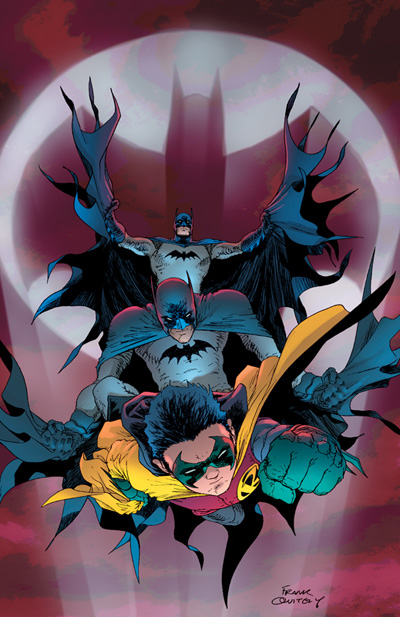
As some of you may have already guessed, ComicsAlliance is basically just an elaborate cover for David Uzumeri and I to try to out-nerd each other about Batman, and today, I’ve got my latest effort to top him: an analysis of the news that there are going to be two Batmen, 1600ish words examining the history of Bat-imposters and ersatz caped crusaders and what impact this is going to have on the story Grant Morrison’s been threading through his run since JLA.
As is the case with most things like this, it started as me jokingly suggesting the above title as a headline for the article, but it turned out to be a question that Laura Hudson thought people might actually want to know. Thus, the Internet’s Foremost Batmanologist is back in session.
So while the Brand Ecch news sites may have just reposted the press release and Yannick Paquette’s (friggin’ amazing) preview page, we went the extra mile! So until Caleb Goellner goes with loose fit jeans, Make Yours ComicsAlliance!
…
Uh, sorry. I’ve been reading a lot of ’60s Fantastic Four lately.
Multiple Batmans? That’s the sort of problem you want to have.
Pah. Multiple Batmen, multiple shmetmen.
In 1409-1415, there were THREE SIMULTANEOUS POPES!
Tru fax.
But was a pope simultaneously a Batman?
YOU NEVER HAVE TO APOLOGIZE FOR CLASSIC FF
2 Batmans, 2 Captain Americas: OK, that’s a coincidence.
2 Anita Blakes: Illuminati plot.
Great article.
It’s interesting that DC’s taking the approach that Batman himself is more than just Bruce Wayne, You mention those very early issues on Batman inspiring others to directly take that mantle and follow that path, and it also seems like an idea that is present also in Batman Beyond (especially when seeing Terry’s choices of enacting justice just as himself or with the discipline provided by Bruce as Batman). That essentially there is a legitimate way for the Batman mantle to be passed on is not something you’d think DC would allow, even if it’s for a short period of time.
It seems like the complete opposite of Superman, where after his “death” it seems as if the moral is that nobody can completely replace the Man of Steel. Do you think there’s a particular factor that makes that difference distinct? Is it because Batman is, in the end, still represented by a man (highly trained and in the way of the Bat essentially), while Superman is a foreign creature that no other human can really become?
I think the difference rests completely in Morrison. If you asked another creator, they might go with a completely different take on the Batman legacy — heck, as much as I enjoy them and the idea that Batman really is a force of good on a level beyond just “fighting crime,” I’m partial to Bruce Wayne being unique in his drive and dedication to become Batman. But like with a lot of Morrison stuff, I don’t feel like that’s an immutable tenet of the character, just something I have a preference for.
The thing is, though, Morrison has introduced a Superman Legacy, starting in DC 1,000,000 and then running on through All Star Superman, where we see the people who will carry on his legacy after he’s gone (except in his case, it’s gone into the sun, rather than being dead).
The core idea of Superman for Morrison — and one that he picked up from the Silver Age — isn’t that no human can become Superman, but that on a moral level (and Superman’s real “power” is his morality and dedication to capital-G Good), we can all be Superman. In fact, that’s what he writes on the moon when he’s dying in “The Last Days of Superman” (Superman #156), which is essentially Silver Age All Star: “Do good to others and every man can be a Superman.”
If I had to guess, I’d say that this single panel probably impacted Morrison pretty hard, and what’s going on in Batman is the extension of that, treating both characters as what they are: Symbols that are larger than the “people” behind them.
The thing I love about Paquette’s artwork is that it really brings home that fact that Bruce’s new costume is essentially a spacesuit with an ENORMOUS codpiece.
w00t! It’s like Jean Paul Valley never left!
Chris, you got through all this without even mentioning Hugo Strange, the mad psychiatrist who thought he’d analysed the Batman so perfectly he could become Batman himself? An analysis of his failure seems worth at least a paragraph here.
I filled my recommended allowance of Hugo Strange talk with that thing on Arkham City a couple weeks ago.
Actually, the truth is that there was a lot of stuff I wanted to go into (the Silver Age story on which the three Replacement Batmen are based is something I just recently found, too) but time constraints meant that I shifted my focus onto mostly Morrison stuff. I hate to say it, but even Batwoman was an afterthought after I talked it over to Laura. Tommy Carma got in there because ONE BATMAN TOO MANY! is a favorite from my childhood.
Either way, that’s an excellent point!
My initial impression upon reading this is that Dick Grayson is not long for this earth. I doubt there will be multiple Batmen for the long term, and once you have been one of the DC’s Big Three anything else, i.e. back to Nightwing, would be a demotion, changing his core concept from someone whose parents were murdered in front of him and then inspired by Batman, to someone who didn’t measure up as Batman.
I agree, but part of me really hopes they keep him around as an equal to Batman, as much as I know that it’s not going to be like that.
I just realized where the BATMAN INC. idea came from.
…
BAT-HOMBRE.